Vincent Perot
Reverse Thinking Makes LLMs Stronger Reasoners
Nov 29, 2024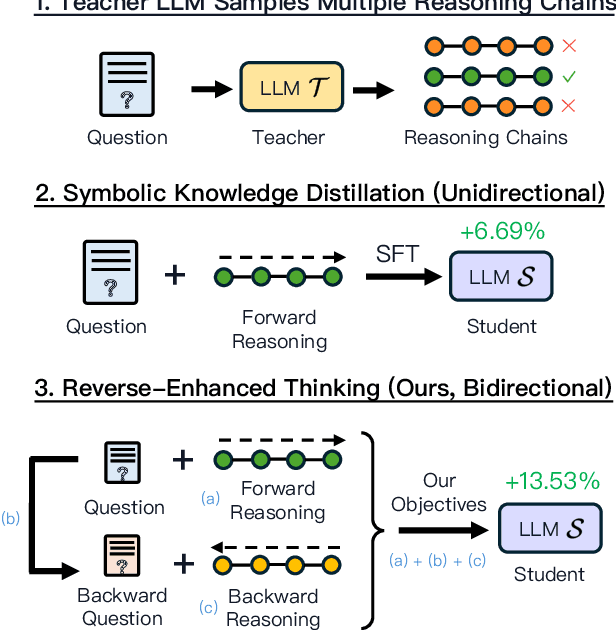
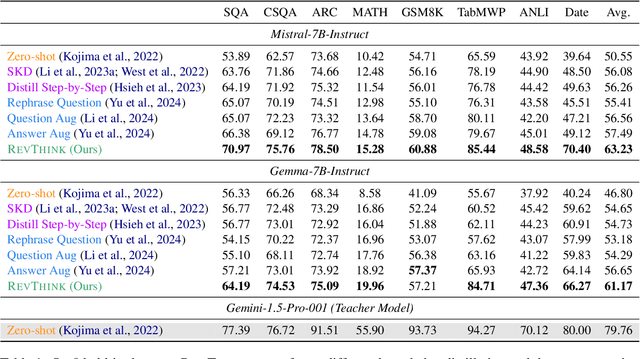
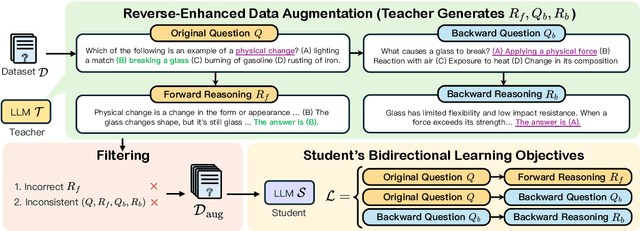

Abstract:Reverse thinking plays a crucial role in human reasoning. Humans can reason not only from a problem to a solution but also in reverse, i.e., start from the solution and reason towards the problem. This often enhances overall reasoning performance as it enables consistency checks between their forward and backward thinking. To enable Large Language Models (LLMs) to perform reverse thinking, we introduce Reverse-Enhanced Thinking (RevThink), a framework composed of data augmentation and learning objectives. In RevThink, we augment the dataset by collecting structured forward-backward reasoning from a teacher model, consisting of: (1) the original question, (2) forward reasoning, (3) backward question, and (4) backward reasoning. We then employ three objectives to train a smaller student model in a multi-task learning fashion: (a) generate forward reasoning from a question, (b) generate a backward question from a question, and (c) generate backward reasoning from the backward question. Experiments across 12 datasets covering commonsense, math, and logical reasoning show an average 13.53% improvement over the student model's zero-shot performance and a 6.84% improvement over the strongest knowledge distillation baselines. Moreover, our method demonstrates sample efficiency -- using only 10% of the correct forward reasoning from the training data, it outperforms a standard fine-tuning method trained on 10x more forward reasoning. RevThink also exhibits strong generalization to out-of-distribution held-out datasets.
Speculative RAG: Enhancing Retrieval Augmented Generation through Drafting
Jul 11, 2024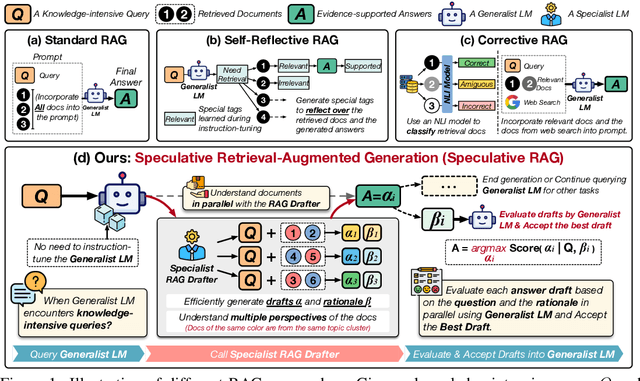
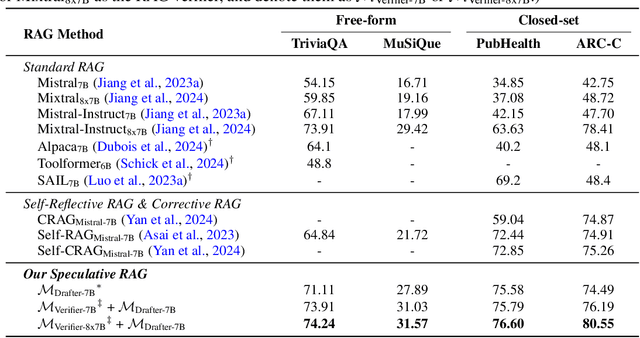

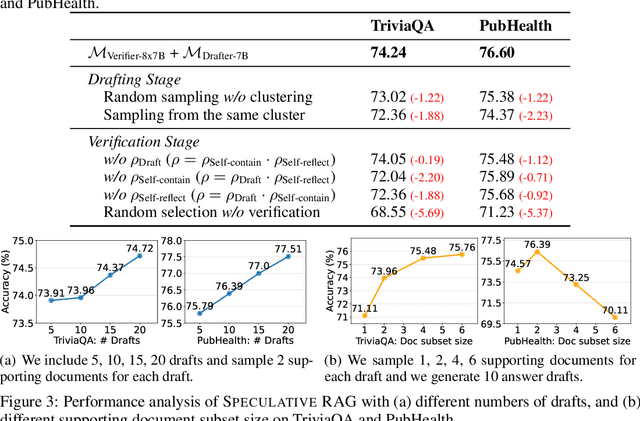
Abstract:Retrieval augmented generation (RAG) combines the generative abilities of large language models (LLMs) with external knowledge sources to provide more accurate and up-to-date responses. Recent RAG advancements focus on improving retrieval outcomes through iterative LLM refinement or self-critique capabilities acquired through additional instruction tuning of LLMs. In this work, we introduce Speculative RAG - a framework that leverages a larger generalist LM to efficiently verify multiple RAG drafts produced in parallel by a smaller, distilled specialist LM. Each draft is generated from a distinct subset of retrieved documents, offering diverse perspectives on the evidence while reducing input token counts per draft. This approach enhances comprehension of each subset and mitigates potential position bias over long context. Our method accelerates RAG by delegating drafting to the smaller specialist LM, with the larger generalist LM performing a single verification pass over the drafts. Extensive experiments demonstrate that Speculative RAG achieves state-of-the-art performance with reduced latency on TriviaQA, MuSiQue, PubHealth, and ARC-Challenge benchmarks. It notably enhances accuracy by up to 12.97% while reducing latency by 51% compared to conventional RAG systems on PubHealth.
Can Long-Context Language Models Subsume Retrieval, RAG, SQL, and More?
Jun 19, 2024


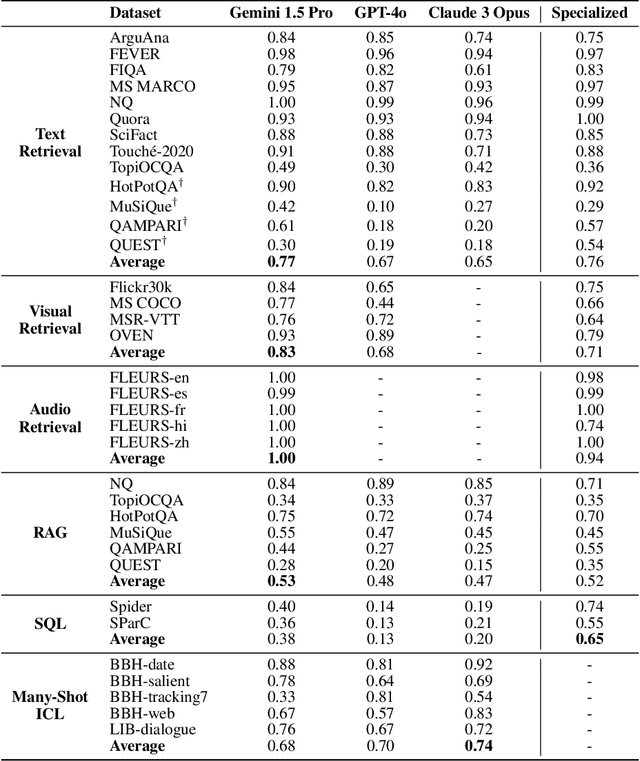
Abstract:Long-context language models (LCLMs) have the potential to revolutionize our approach to tasks traditionally reliant on external tools like retrieval systems or databases. Leveraging LCLMs' ability to natively ingest and process entire corpora of information offers numerous advantages. It enhances user-friendliness by eliminating the need for specialized knowledge of tools, provides robust end-to-end modeling that minimizes cascading errors in complex pipelines, and allows for the application of sophisticated prompting techniques across the entire system. To assess this paradigm shift, we introduce LOFT, a benchmark of real-world tasks requiring context up to millions of tokens designed to evaluate LCLMs' performance on in-context retrieval and reasoning. Our findings reveal LCLMs' surprising ability to rival state-of-the-art retrieval and RAG systems, despite never having been explicitly trained for these tasks. However, LCLMs still face challenges in areas like compositional reasoning that are required in SQL-like tasks. Notably, prompting strategies significantly influence performance, emphasizing the need for continued research as context lengths grow. Overall, LOFT provides a rigorous testing ground for LCLMs, showcasing their potential to supplant existing paradigms and tackle novel tasks as model capabilities scale.
CodecLM: Aligning Language Models with Tailored Synthetic Data
Apr 08, 2024



Abstract:Instruction tuning has emerged as the key in aligning large language models (LLMs) with specific task instructions, thereby mitigating the discrepancy between the next-token prediction objective and users' actual goals. To reduce the labor and time cost to collect or annotate data by humans, researchers start to explore the use of LLMs to generate instruction-aligned synthetic data. Recent works focus on generating diverse instructions and applying LLM to increase instruction complexity, often neglecting downstream use cases. It remains unclear how to tailor high-quality data to elicit better instruction-following abilities in different target instruction distributions and LLMs. To this end, we introduce CodecLM, a general framework for adaptively generating high-quality synthetic data for LLM alignment with different downstream instruction distributions and LLMs. Drawing on the Encode-Decode principles, we use LLMs as codecs to guide the data generation process. We first encode seed instructions into metadata, which are concise keywords generated on-the-fly to capture the target instruction distribution, and then decode metadata to create tailored instructions. We also introduce Self-Rubrics and Contrastive Filtering during decoding to tailor data-efficient samples. Extensive experiments on four open-domain instruction following benchmarks validate the effectiveness of CodecLM over the current state-of-the-arts.
Noise-Aware Training of Layout-Aware Language Models
Mar 30, 2024Abstract:A visually rich document (VRD) utilizes visual features along with linguistic cues to disseminate information. Training a custom extractor that identifies named entities from a document requires a large number of instances of the target document type annotated at textual and visual modalities. This is an expensive bottleneck in enterprise scenarios, where we want to train custom extractors for thousands of different document types in a scalable way. Pre-training an extractor model on unlabeled instances of the target document type, followed by a fine-tuning step on human-labeled instances does not work in these scenarios, as it surpasses the maximum allowable training time allocated for the extractor. We address this scenario by proposing a Noise-Aware Training method or NAT in this paper. Instead of acquiring expensive human-labeled documents, NAT utilizes weakly labeled documents to train an extractor in a scalable way. To avoid degradation in the model's quality due to noisy, weakly labeled samples, NAT estimates the confidence of each training sample and incorporates it as uncertainty measure during training. We train multiple state-of-the-art extractor models using NAT. Experiments on a number of publicly available and in-house datasets show that NAT-trained models are not only robust in performance -- it outperforms a transfer-learning baseline by up to 6% in terms of macro-F1 score, but it is also more label-efficient -- it reduces the amount of human-effort required to obtain comparable performance by up to 73%.
Chain-of-Table: Evolving Tables in the Reasoning Chain for Table Understanding
Jan 19, 2024Abstract:Table-based reasoning with large language models (LLMs) is a promising direction to tackle many table understanding tasks, such as table-based question answering and fact verification. Compared with generic reasoning, table-based reasoning requires the extraction of underlying semantics from both free-form questions and semi-structured tabular data. Chain-of-Thought and its similar approaches incorporate the reasoning chain in the form of textual context, but it is still an open question how to effectively leverage tabular data in the reasoning chain. We propose the Chain-of-Table framework, where tabular data is explicitly used in the reasoning chain as a proxy for intermediate thoughts. Specifically, we guide LLMs using in-context learning to iteratively generate operations and update the table to represent a tabular reasoning chain. LLMs can therefore dynamically plan the next operation based on the results of the previous ones. This continuous evolution of the table forms a chain, showing the reasoning process for a given tabular problem. The chain carries structured information of the intermediate results, enabling more accurate and reliable predictions. Chain-of-Table achieves new state-of-the-art performance on WikiTQ, FeTaQA, and TabFact benchmarks across multiple LLM choices.
LMDX: Language Model-based Document Information Extraction and Localization
Sep 19, 2023Abstract:Large Language Models (LLM) have revolutionized Natural Language Processing (NLP), improving state-of-the-art on many existing tasks and exhibiting emergent capabilities. However, LLMs have not yet been successfully applied on semi-structured document information extraction, which is at the core of many document processing workflows and consists of extracting key entities from a visually rich document (VRD) given a predefined target schema. The main obstacles to LLM adoption in that task have been the absence of layout encoding within LLMs, critical for a high quality extraction, and the lack of a grounding mechanism ensuring the answer is not hallucinated. In this paper, we introduce Language Model-based Document Information Extraction and Localization (LMDX), a methodology to adapt arbitrary LLMs for document information extraction. LMDX can do extraction of singular, repeated, and hierarchical entities, both with and without training data, while providing grounding guarantees and localizing the entities within the document. In particular, we apply LMDX to the PaLM 2-S LLM and evaluate it on VRDU and CORD benchmarks, setting a new state-of-the-art and showing how LMDX enables the creation of high quality, data-efficient parsers.
FormNetV2: Multimodal Graph Contrastive Learning for Form Document Information Extraction
May 04, 2023
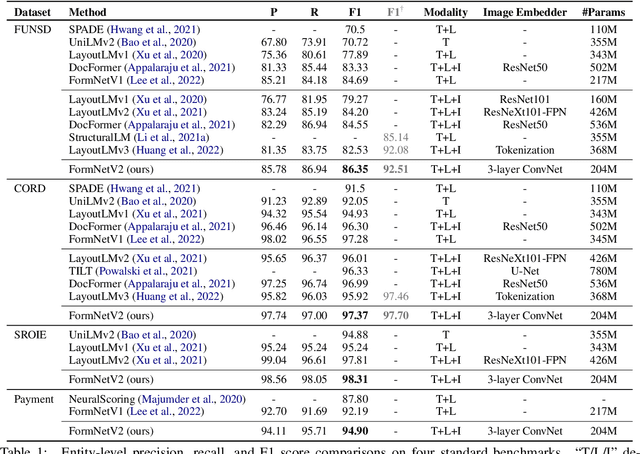
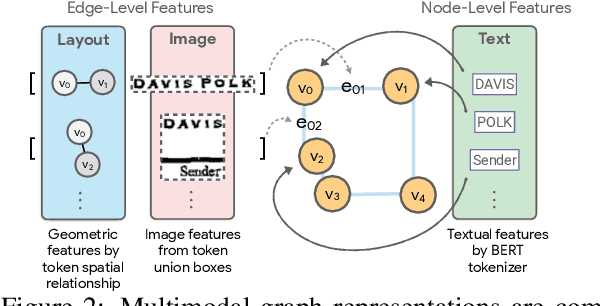

Abstract:The recent advent of self-supervised pre-training techniques has led to a surge in the use of multimodal learning in form document understanding. However, existing approaches that extend the mask language modeling to other modalities require careful multi-task tuning, complex reconstruction target designs, or additional pre-training data. In FormNetV2, we introduce a centralized multimodal graph contrastive learning strategy to unify self-supervised pre-training for all modalities in one loss. The graph contrastive objective maximizes the agreement of multimodal representations, providing a natural interplay for all modalities without special customization. In addition, we extract image features within the bounding box that joins a pair of tokens connected by a graph edge, capturing more targeted visual cues without loading a sophisticated and separately pre-trained image embedder. FormNetV2 establishes new state-of-the-art performance on FUNSD, CORD, SROIE and Payment benchmarks with a more compact model size.
QueryForm: A Simple Zero-shot Form Entity Query Framework
Nov 14, 2022Abstract:Zero-shot transfer learning for document understanding is a crucial yet under-investigated scenario to help reduce the high cost involved in annotating document entities. We present a novel query-based framework, QueryForm, that extracts entity values from form-like documents in a zero-shot fashion. QueryForm contains a dual prompting mechanism that composes both the document schema and a specific entity type into a query, which is used to prompt a Transformer model to perform a single entity extraction task. Furthermore, we propose to leverage large-scale query-entity pairs generated from form-like webpages with weak HTML annotations to pre-train QueryForm. By unifying pre-training and fine-tuning into the same query-based framework, QueryForm enables models to learn from structured documents containing various entities and layouts, leading to better generalization to target document types without the need for target-specific training data. QueryForm sets new state-of-the-art average F1 score on both the XFUND (+4.6%~10.1%) and the Payment (+3.2%~9.5%) zero-shot benchmark, with a smaller model size and no additional image input.
DualPrompt: Complementary Prompting for Rehearsal-free Continual Learning
Apr 10, 2022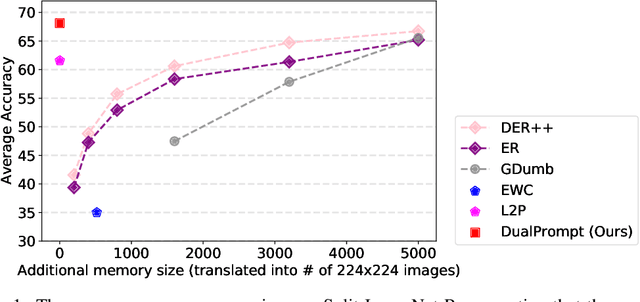
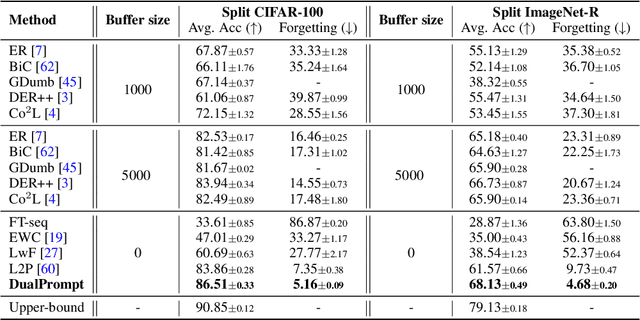

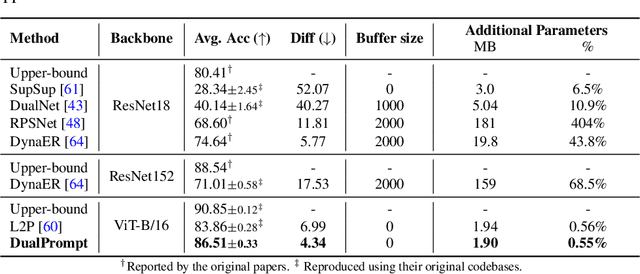
Abstract:Continual learning aims to enable a single model to learn a sequence of tasks without catastrophic forgetting. Top-performing methods usually require a rehearsal buffer to store past pristine examples for experience replay, which, however, limits their practical value due to privacy and memory constraints. In this work, we present a simple yet effective framework, DualPrompt, which learns a tiny set of parameters, called prompts, to properly instruct a pre-trained model to learn tasks arriving sequentially without buffering past examples. DualPrompt presents a novel approach to attach complementary prompts to the pre-trained backbone, and then formulates the objective as learning task-invariant and task-specific "instructions". With extensive experimental validation, DualPrompt consistently sets state-of-the-art performance under the challenging class-incremental setting. In particular, DualPrompt outperforms recent advanced continual learning methods with relatively large buffer sizes. We also introduce a more challenging benchmark, Split ImageNet-R, to help generalize rehearsal-free continual learning research. Source code is available at https://github.com/google-research/l2p.
 Add to Chrome
Add to Chrome Add to Firefox
Add to Firefox Add to Edge
Add to Edge